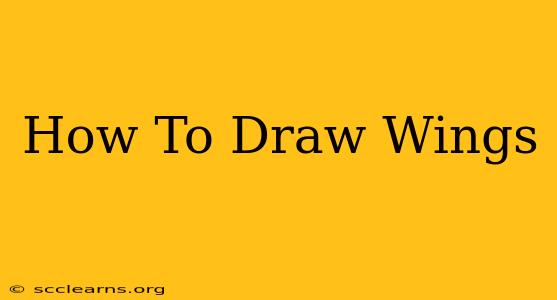So you want to learn how to draw wings? Whether you're aiming for the delicate flutter of a hummingbird's wings or the majestic sweep of an eagle's, this comprehensive guide will equip you with the skills and knowledge to bring your winged creations to life. We'll cover everything from basic shapes to advanced techniques, ensuring you can draw wings with confidence and artistry.
Understanding Wing Anatomy: The Foundation of Realistic Wings
Before diving into the drawing process, let's understand the fundamental structure of wings. This knowledge will be crucial in creating believable and aesthetically pleasing wing designs.
Key Elements of Wing Structure:
- Primary Feathers: These are the long, outermost feathers responsible for lift and propulsion. They are typically longer and more pointed than secondary feathers.
- Secondary Feathers: Located closer to the body, these feathers provide stability and lift. They are generally shorter and broader than primary feathers.
- Wingspan: This is the distance from the tip of one wing to the tip of the other wing.
- Wing Area: The overall surface area of the wing plays a significant role in flight capabilities.
- Flight Muscles: Although not directly visible, understanding the underlying muscles that control wing movement is essential for depicting dynamic poses.
Basic Shapes and Simple Wing Drawings: Starting Your Journey
Let's start with the basics. We can break down wing shapes into simple geometric forms, which will serve as your foundation for more complex designs.
Step-by-Step Guide to Drawing Simple Wings:
- Start with a basic shape: Begin by sketching a simple oval or elongated teardrop shape. This will represent the main body of the wing.
- Add primary feathers: Draw slightly curved lines emanating from the outer edge of the oval, representing the primary feathers. Vary the length and curvature for a more natural look.
- Incorporate secondary feathers: Add shorter, more rounded lines to the inner part of the oval, depicting the secondary feathers. Overlap the feathers slightly to create depth and realism.
- Refine the shape: Smooth out the lines, add subtle curves, and erase any unnecessary guidelines.
- Add details: Consider adding subtle variations in feather thickness, texture, and shading to enhance realism.
Drawing Different Types of Wings: From Birds to Angels
Now that you've mastered the basics, let's explore how to draw various types of wings, each with its unique characteristics.
Bird Wings:
- Birds of Prey: Emphasize the powerful, broad wings of eagles or hawks, showcasing their sharp primary feathers and strong, curved wing shape.
- Smaller Birds: Create delicate, more rounded wings for hummingbirds, sparrows, or other small birds. Focus on creating a sense of lightness and fragility.
- Waterfowl: Illustrate the longer, pointed wings of ducks, geese, or swans, paying attention to their streamlined shape and smooth feather patterns.
Fantasy Wings:
- Angel Wings: Depict large, powerful wings with a more stylized, almost architectural feel. Consider adding details like flowing feathers and subtle textures.
- Dragon Wings: Showcase the leathery, scaled texture of dragon wings, paying close attention to their intricate detailing and powerful musculature.
- Mythical Creatures: Use your imagination to create unique wing designs for any mythical creature, drawing inspiration from nature while adding your own creative flair.
Advanced Techniques for Realistic Wing Drawings: Mastering the Art
Let's delve into advanced techniques to elevate your wing drawings to the next level.
Adding Depth and Dimension:
- Shading and highlighting: Utilize shading to create depth and form, and strategically place highlights to enhance the three-dimensionality of the wings.
- Perspective: Understand how perspective affects the appearance of wings in different positions and angles.
- Texture: Experiment with various techniques to create a believable texture for the feathers, such as cross-hatching, stippling, or blending.
Dynamic Poses:
- Movement: Capture the movement and flow of the wings in flight through dynamic line work and careful attention to feather placement.
- Interaction with the body: Consider how the wings interact with the body of the creature, emphasizing the connection between the two.
Practice Makes Perfect: Your Wing Drawing Journey
Remember, the key to mastering any artistic skill is consistent practice. Experiment with different techniques, styles, and types of wings. Don't be afraid to make mistakes—they are opportunities for learning and growth. With dedication and practice, you'll be creating breathtaking wing drawings in no time! So grab your pencils and paper, and unleash your creativity!

